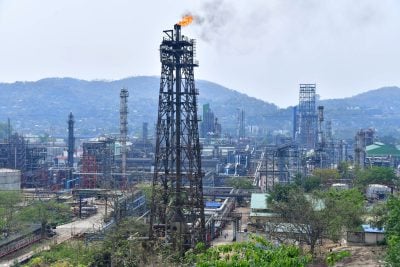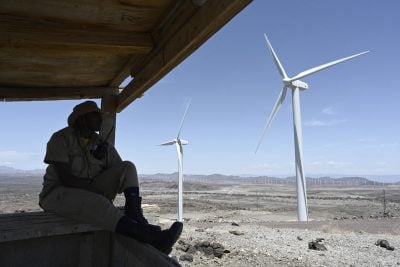Before war erupted last November in Ethiopia’s Tigray region, the Almeda textile factory supplied some of Europe and America’s top brands with low-cost garments and provided jobs to more than 300 people, most of them women.
Almeda was part of Ethiopia’s bid to make its textile industry globally competitive, by enticing investors with a young and economical workforce and the promise of attractive margins for suppliers to household-name global brands.
Now the factory lies in ruins, burnt to the ground after being looted – according to eyewitness accounts – by Eritrean forces.
The war between Ethiopia’s central government and the Tigray regional government, led by the Tigray People’s Liberation Front (TPLF), which has drawn in troops from Eritrea, could be potentially devastating to the future of the garment industry. Amnesty International says that 450,000 people have been displaced in the region, and 2.3m of its 7m population are in immediate need of life-saving assistance.
The Ethiopian textile sector was already battling the twin impacts of Covid and reduced exports, and now the Tigray war has put “long-lasting dents” on Ethiopia’s prior success, according to Manoj Tiwari, a global textiles expert at the National Institute of Fashion Technology, India.
“Mekelle [the capital city of the Tigray region] is the most important textile hub of Ethiopia, and due to the war, it has been severely affected,” he says.
“The situation is expected to improve in the near future, and I hope industrial activities will be able to resume soon, as Ethiopia offers a bright and promising hope to the global textile industry, provided labour, safety and health concerns, wages and uplift of living standards and issues to do with low productivity and better skilled labour are addressed efficiently, effectively, and quickly. Ethiopia’s push into the textile industry over the past 10 years has been emblematic of its manufacturing ambitions.”

The Ethiopian Ministry of Trade and Industry has confirmed it is losing $20m per day in exports due to the closure of factories and mining plants in Tigray.
Addis Ababa still plans to increase clothing exports to $30bn a year by 2030, from its current $145m base, as part of a push to see Ethiopia become a lower-middle income country by 2025. The Ethiopian government has built industrial parks in cities across the country, issuing textile licences to over 175 manufacturers in a bid to increase the sector’s share of total exports to roughly 10%, representing 0.6% of total GDP.
Most foreign investors come from China and India, while leading Bangladeshi textile firm DBL was forced to evacuate 103 of its foreign staff from the country when the war began. It’s unclear when they will be able to return.
Egyptian investors are awaiting the Ethiopian government’s response to requests for $2m compensation for losses incurred in the region. SCM Knit Tex Plc, an Indian textile company based in Tigray, has been more fortunate. Its 1,300 employers and factory were protected by federal Ethiopian forces when fighting broke out, allowing operations to continue.
The Ethiopian government declared victory four months ago, but the conflict risks becoming a prolonged guerilla struggle. The IMF has forecast 0% GDP growth in real terms in 2021, as rising debt repayments to China threaten to choke Ethiopia’s industrial ambitions.
Responding to the pandemic
An accurate number of textile workers is difficult to gauge, but analysts estimate it is well over 60,000. When Covid cases began steadily rising last year, many garment workers were too afraid to go to work. This prompted a collaboration between the Ethiopian government and development arms of the UK and German governments to provide financial assistance to employees.
A 2019 survey of over 1,000 textile workers across 52 factories in three regions found 65% earn less than $70 per month, with many making less than half of that.
“Most workers in the textile industry are poorly paid women so the social consequences of mass unemployment in the sector were potentially severe,” says Mark Napier, CEO of Financial Sector Deepening (FSD) Africa.
“Textile manufacturing is a global business. Buyers can switch production from Ethiopia to Kenya or Bangladesh relatively quickly. So the nascent Ethiopian textiles industry really was vulnerable, and for Ethiopia to lose this industry, which forms a key plank of its industrialisation strategy, after so much government and donor support, would have been a tragedy.”
An initial $6.5m fund to which Ethiopia’s industrial parks could apply for wage subsidies was created and Napier says 35,000 jobs in 30 factories have been secured. Funds are ring-fenced to support the six large factories in Tigray when the security situation improves.
“Textiles manufacturing is a significant source of employment – especially for women – a tax base for the country, inward investment from international partners and an opportunity to demonstrate investment. Donors can continue to play a role, especially in capacity building and improving working conditions,” says Napier.
For the Ethiopian government, it’s hoped the country’s closer proximity to Europe and North America compared to Asian countries, industrial funding provisions, exemptions in customs duties and tax holidays for foreign firms and international agreements for trade promotion can elevate Ethiopia to become the “Bangladesh of Africa”.

And for Lelise Neme, at the Ethiopian Investment Commission, improved security is paramount for providing fertile ground for added inward investment.
“The government is proactively addressing peace and security challenges that threaten investments in the country, and this is significantly observed with the recent law enforcement operation taken in response to the TPLF’s violation of the national constitution,” Neme tells African Business.
“Currently, the country has just launched a 10-year perspective plan and a three-year home-grown economic programme which give prime attention to competitiveness, industry-led growth and private sector development, to become a middle income country in 2025 and achieve the Sustainable Development Goals (SDGs) by 2030. This action also assures the establishment of a safe and secure investment climate in the country.”
Glimmers of hope
Despite poor security in Tigray and the unprecedented shock from Covid-19, glimmers of hope have emerged. The biggest firm in the handcraft segment of the textiles industry reported a 92% growth in exports in 2020. And an expanding cotton and leather industry, together with new railways and roads, are laying the foundations for increased exports.
Kathy Marshall moved to Ethiopia from Canada 26 years ago and set up Sabahar, a producer of hand-woven textiles using only natural fibres including cotton, silk and line. With 96 full-time employees it exports to 11 countries worldwide.
“There’s growing market opportunities for high-quality authentic hand-woven products, as people are tired of feeling like they’ve had the wool pulled over their eyes with products from China claiming that it is handmade or authentic,” she says.
“I think the international customer that we’re engaged with in this sector is very interested by Ethiopia’s unique textile weaving tradition.”
Want to continue reading? Subscribe today.
You've read all your free articles for this month! Subscribe now to enjoy full access to our content.
Digital Monthly
£8.00 / month
Receive full unlimited access to our articles, opinions, podcasts and more.
Digital Yearly
£70.00 / year
Our best value offer - save £26 and gain access to all of our digital content for an entire year!

 Sign in with Google
Sign in with Google 





